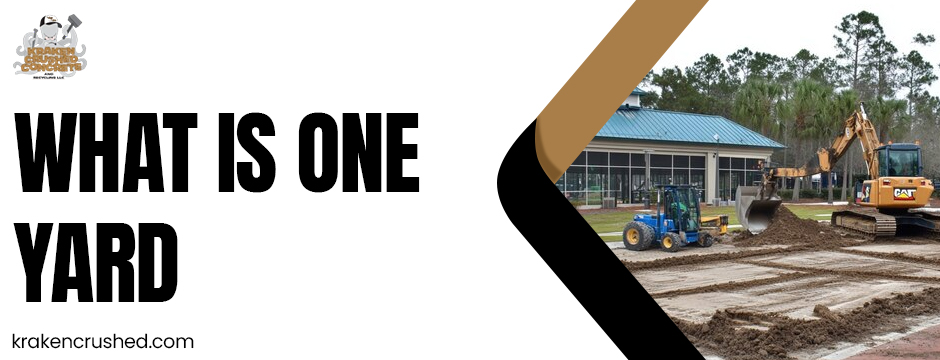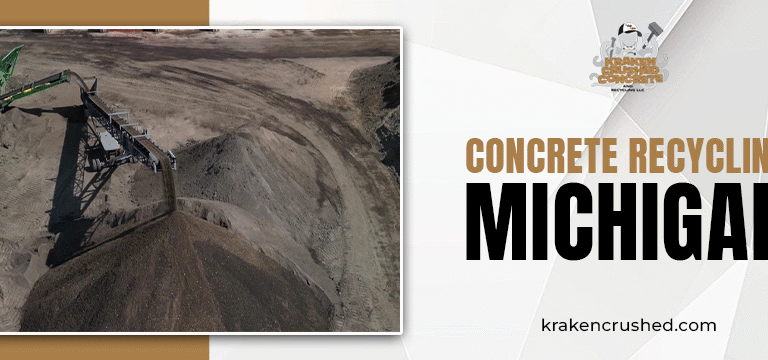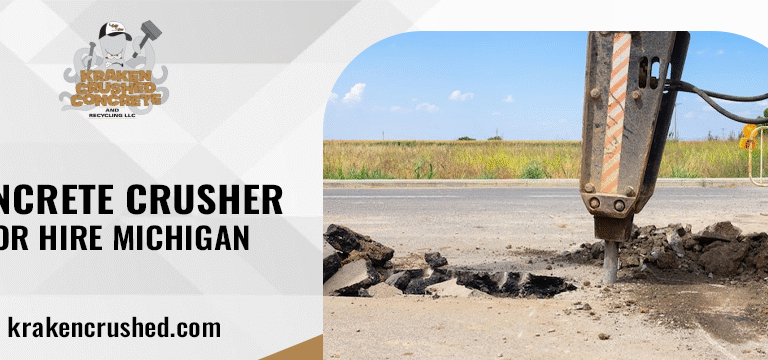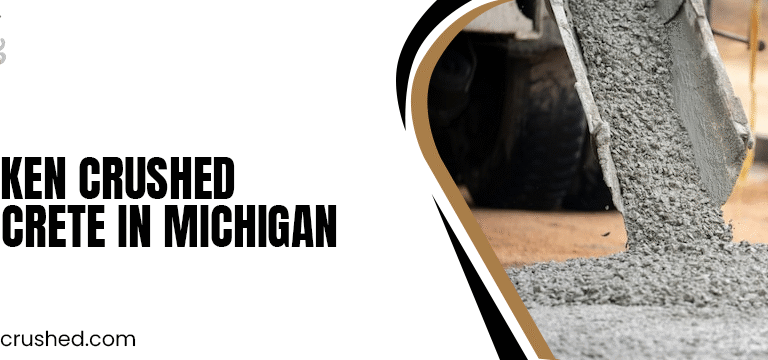If you’ve ever ordered gravel, concrete, or mulch, chances are someone mentioned “cubic yards.” It’s one of those construction terms that gets used constantly but rarely explained. Ask ten different people what a cubic yard actually is, and you might get ten different answers.

At Kraken Crushed Concrete, we hear it all the time. Homeowners often say, “I just need enough to fill the driveway,” or “a couple of truckloads should do it.” But unless you understand what a cubic yard measures, it’s almost impossible to order the right amount—and that can cost time and money.
Let’s clear it up once and for all.
So, What Exactly Is a Cubic Yard?
A cubic yard is simply a way of measuring volume—the space something fills. One cubic yard equals 27 cubic feet, or a cube that’s three feet long, three feet wide, and three feet high.
Picture a big cardboard box. If that box was three feet in every direction and you filled it with crushed concrete or soil, that’s one cubic yard.
To make it easier to visualize:
- One cubic yard of mulch roughly fills the bed of a small pickup truck.
- It takes about four wheelbarrows to move a cubic yard.
- And if you’ve ever seen a washing machine, it’s close to that size.
That’s it. Nothing fancy—just a standard way to measure bulk materials so everyone’s speaking the same language.
Why That Measurement Matters
When you’re working on a construction or landscaping project, accuracy matters. If you don’t order enough, the crew stops mid-job waiting for more. If you order too much, you’ve got piles of extra material sitting around.
Knowing what is cubic yard helps you avoid both problems. It’s not just a unit of measure—it’s a planning tool.
At Kraken Crushed Concrete, we sell our materials—gravel, crushed concrete, fill dirt, and topsoil—by the cubic yard. That’s because density and weight vary from one material to another. A cubic yard of crushed concrete doesn’t weigh the same as a cubic yard of mulch, but the space it fills is identical. It keeps things consistent and transparent.
The Real Cost of Guessing
We’ve seen it happen: a customer orders “two truckloads” of fill, thinking it’ll cover their whole yard. By mid-afternoon, the crew runs out, and the truck has to come back. That’s another delivery fee, another delay, and sometimes another day lost.
When you measure in cubic yards, you take out the guesswork. You’ll know exactly how much material your space can hold before the first shovel hits the ground. The math is simple and saves real money.
Cubic Yards in Construction
On a construction site, cubic yards are used for nearly everything. Concrete, crushed rock, soil—each one is priced and poured by the yard.
A few examples:
- Concrete: Driveways, footings, or foundations are all ordered in cubic yards. A single ready-mix truck usually holds about 8–10 cubic yards, which can pour an entire driveway or small slab.
- Crushed Concrete and Gravel: Used as base layers for roads, parking areas, and pads. Measuring in cubic yards helps ensure even coverage and proper depth.
- Fill Dirt or Topsoil: Essential for grading, backfilling, and landscaping. Measuring by volume instead of weight keeps your project balanced.
We’ve helped contractors and homeowners calculate their needs hundreds of times. Once you get used to thinking in cubic yards, everything from budgeting to delivery scheduling becomes simpler.
Cubic Yards in Landscaping Projects
In landscaping, precision is just as important. Knowing how many cubic yards you need helps create smooth finishes, clean lines, and consistent coverage.
Here’s a quick breakdown:
- Mulch: One cubic yard covers about 100 square feet at 3 inches deep.
- Topsoil: One cubic yard covers roughly 80–100 square feet at 3 inches deep.
- Gravel: One cubic yard covers around 100 square feet at 2–3 inches deep.
So if you’re refreshing garden beds, building a pathway, or grading your yard, this measurement keeps your plan realistic. Nothing’s worse than running short with one corner still bare.
How to Figure Out How Many Cubic Yards You Need
You don’t need fancy tools for this—just a tape measure, a calculator, and a few minutes.
- Measure the length, width, and depth of your space in feet.
- Multiply them together to get the cubic feet.
- Divide that number by 27 (since 1 cubic yard = 27 cubic feet).
For example:
A garden bed that’s 12 feet long, 6 feet wide, and 0.5 feet deep (6 inches) would be:
12 × 6 × 0.5 = 36 cubic feet
36 ÷ 27 = 1.33 cubic yards
So you’d order about one and a third cubic yards of soil to fill it nicely.
If math isn’t your favorite thing, don’t worry—our team at Kraken Crushed Concrete can help you calculate it. We do this all the time for our customers, making sure they get the right amount every single time.
Cubic Yards vs. Tons: The Common Mix-Up
Here’s where many people get confused. A ton measures weight, but a cubic yard measures volume. They’re not interchangeable.
For example:
- One cubic yard of crushed concrete weighs about 2,400 pounds (1.2 tons).
- One cubic yard of mulch weighs roughly 500–800 pounds.
So if you order by the ton, you might end up with a different amount of material than you expected. Ordering by cubic yard makes sure you’re filling the right amount of space, not just hitting a weight number.
The Money-Saving Side of Knowing Your Measurements
Every load of material has a cost attached to it—product, delivery, and labor. When you calculate properly, you only pay for what you truly need. That’s why understanding the measurements of a yard of material pays off quickly.
At Kraken Crushed Concrete, we’ve seen customers cut project costs simply by ordering the right amount the first time. Our recycled crushed concrete is not only affordable but eco-friendly, reducing landfill waste while delivering solid performance for driveways, foundations, and landscape bases.
It’s a smarter, greener choice—and precision measuring is part of that.
Truck Loads, Space, and Efficiency
Every delivery truck has a limit on how many cubic yards it can safely carry. If your order exceeds that capacity, we’ll plan it in multiple loads to keep things safe and efficient.
For example, one of our dump trucks typically hauls 10–12 cubic yards of lighter material like mulch, but only 6–8 cubic yards of heavier material like crushed concrete.
By understanding this up front, you can plan your schedule and budget more accurately. We’ll always walk you through it before delivery so there are no surprises.
Quick Reference: Measurements of a Yard of Material
| Material | Approx. Weight | Average Coverage | Typical Truck Capacity |
| Crushed Concrete | 2,400 lbs | 100 sq ft (2–3” deep) | 6–8 cubic yards |
| Gravel | 2,700 lbs | 100 sq ft (2–3” deep) | 5–8 cubic yards |
| Topsoil | 2,200 lbs | 80–100 sq ft (3” deep) | 6–8 cubic yards |
| Mulch | 600 lbs | 100 sq ft (3” deep) | 10–12 cubic yards |
Keep this chart handy—it’s a quick cheat sheet for planning your next job.
Why People Keep Coming Back to Kraken Crushed Concrete
We don’t just deliver crushed concrete. We help people get it right. Every day, we work with builders, landscapers, and homeowners who want to stretch their budgets without sacrificing quality.
When you call us, you’ll talk to someone who knows what they’re doing—not a call center. We’ll walk you through your measurements, recommend materials that fit your project, and make sure your order arrives exactly when you need it.
That’s what keeps customers coming back. We’re local, reliable, and proud to help our community build smarter.
Wrapping It Up
Understanding what is cubic yard might not sound like a big deal at first, but it’s one of those details that can make or break a project. It helps you stay on budget, plan deliveries efficiently, and get clean, professional results.
At Kraken Crushed Concrete, we take pride in helping our customers get their measurements right the first time. Whether you’re pouring a driveway, laying a patio base, or leveling a new yard, our team is here to make sure you get exactly what you need—no waste, no shortfalls, no stress.
Next time you’re planning a project, give us a call. We’ll help you figure out your cubic yard requirements and deliver the right material straight to your site. Because a little knowledge and precision can save a lot of money.






